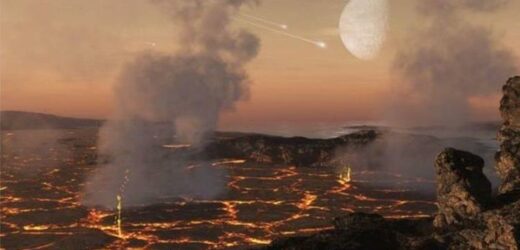Asteroid A10sHcN: Simulator maps orbit near Earth
We use your sign-up to provide content in ways you’ve consented to and to improve our understanding of you. This may include adverts from us and 3rd parties based on our understanding. You can unsubscribe at any time. More info
Giant asteroids once peppered the early Earth’s surface to create an incredibly violent environment. But, scientists have now revealed that these bombardments of space impactors happened far more than previously believed.
We already know that several large meteor strikes hit Earth before the arrival of humans.
Most notably, the Chicxulub asteroid hit Earth about 66 million years ago, which ultimately led to the extinction of the dinosaurs.
The asteroid is believed to be about 150km wide, and created the 10km-wide Chicxulub Crater near the Gulf of Mexico.
Similar asteroids likely played a huge role in shaping the Earth’s surface and atmosphere into what it’s like today.

It’s previously been difficult to estimate how many similar events occurred in our planet’s history, however.
While we can see craters on the Moon and some other planets, atmospheric weathering and plate tectonics make it increasingly difficult to find evidence of ancient craters on Earth.
But, it’s now been revealed that these huge asteroid events likely happened about 10 times more often than previously thought.
That means between 3.5 and 2.5 billion years ago, Earth could’ve been hit by similar-sized asteroids to Chicxulub every 15 million years, according to researchers at the Southwest Research Institute.
DON’T MISS
Asteroid bigger than a passenger plane due for a close approach [LATEST]
UFO ‘found’ in crater on asteroid belt planet Ceres – claim [ANALYSIS]
Asteroid twice the size of Statue of Liberty to pass Earth [NEWS]
Evidence of historic asteroid impacts can be revealed by analysing ‘spherules’, they said.
Spherules are molten particles and vapours that became trapped inside rocks as small spherical particles.
Each impact would generate spherules, which would ultimately become embedded in the Earth’s surface.
The larger the impact, the more spherules would be generated, they added.

Researcher Dr Simone Marchi said: “With this approach, we found that current models of Earth’s early bombardment severely underestimate the number of known impacts, as recorded by spherule layers.
“The true impact flux could have been up to a factor of 10 times higher than previously thought in the period between 3.5 and 2.5 billion years ago.
“This means that in that early period, we were probably being hit by a Chicxulub-sized impact on average every 15 million years. Quite a spectacle!
“It is likely these energetic events fundamentally altered the Earth’s surface and atmospheric evolution.”
It’s been suggested that large meteor strikes could have affected the amount of oxygen in the atmosphere, for example.
The amount of oxygen in the environment drastically changed during a similar period of history.
So, it’s likely that the two events were linked – although more research is needed to find exactly how.
If asteroids did help to shape atmospheric oxygen, then it’s plausible that they subsequently helped to allow for the development of humans.
Source: Read Full Article

